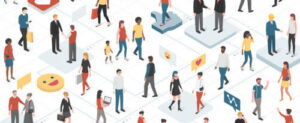How we will work in 2021
- 6 Min Read
How businesses will approach workplace models in the time to come.
- Author: HRD Connect
- Date published: Feb 24, 2021
- Categories

In this new series created in collaboration with ADP, alongside our February event ‘The Organisational Culture Agenda For 2021’, we examine key strategic work priorities in the time to come, including ways of working, health and wellbeing and employee engagement. Contributing to each article are Annabel Jones, UK HR Director of ADP, and Jeff Phipps, Managing Director, ADP UK and Ireland.
In the first edition, a major issue for organisations and employees alike: how we will work in 2021. There are three models that businesses could adopt: remote working, with employees distributed far and beyond; co-located working, a return to the trusted pre-pandemic model; and hybrid working, where employees have flexibility over where they’re deployed.
In the first instance, businesses say goodbye to a central workplace and instead change their processes to work on a remote basis. According to this model, HR teams could hire from a global talent pool, reallocate resources previously spent on high city rent, make best use of digital tools, from team chats to payroll software, and benefit from employees being in an environment that they’re familiar with. However, risks include creating a seamless remote working process, maintaining engagement and wellbeing, guaranteeing productivity, and ensuring health and safety processes are compliant.
At the other end of the scale, businesses are looking to a full return to co-located working. This would mean all the hallmarks of work as we know it, like commuting back and forth, informal chats and meetings, team building exercises, and full employee visibility. By the same token, many of the old problems would remerge, including presenteeism, burnout, interruptions, and new issues, like whether spaces are properly sanitized and reassuring to anxious employees.
Many leaders expect businesses to adopt a hybrid model, utilizing the best aspects of co-located and remote working to build workplaces fit for the organisation’s goals and employees’ needs. It could see employees adopt flexible hours between the office and home, offices become a space of collaboration and idea formation, with the online services, like document sharing and payroll services, that we’ve become accustomed to helping to facilitate this new working model.
The rise of flexibility in work
According to The Workforce View 2020 from ADP, 44% of employers now have official flexible working policies in place, a rise of 20% on the previous year.
This would’ve been a massive change for employees and leaders alike; Jeff Phipps, Managing Director of ADP UK and Ireland, details the positive values that organisations can adopt from this shake up: “We can discover experiences about how people behave, how you go through periods of difficulty, there are lots of lessons out there that we can adopt.
The word ‘curious’ means a lot for me this year; we’ve got to learn from ourselves, from our colleagues, and from others as to what the strategy should look like.”
Annabel Jones, UK HR Director of ADP, outlines how discussions around ways of working have gained a recent urgency: “The pandemic has sped up the conversation. We’ve had to make that a reality now, and I think we’ve had to really start thinking about how we work differently.
In terms of strategy, it’s an agile one, but you’ve got to be realistic that it’s going to change as we go through the next 12 to 18 months.”
Prioritising change management
From the Workforce View 2020, produced by ADP, 22% of respondents believe their job would not exist in five years, however, 65% feel that they will have opportunities in the future; how can leaders’ strategies address these concerns, tackling specific challenges like increasing automation?
According to Jones, the solution lies in effective change management, the processes that prepare, help and enable employees to succeed through organisational development; “It’s about being able to set the scene for your employees and to make sure they’re aware of what the future looks like, what the future direction of the company is, being transparent and how it might affect them.
It comes down to good communication, being able to provide training, being able to create opportunities for people to reskill. That’s the tactical side of things, but it all starts with being clear on where the company’s going and why.”
For Phipps, more needs to be made of how technology will help employees and even increase the opportunities on offer; “Technology is changing repetitive and error-prone tasks. Without technology, we’re creating more work because we’re having to go and resolve an error, say with customer problems.
If you can say, ‘we’re going to have 20 less of these calls you’re going to do,’ then you’re making the job better. You need to think carefully about what the incentives are.”
Meeting organisational objectives in work
Within a changing marketplace, Phipps describes the organisational objectives as consistent; “Is the business growing? Is it healthy? Is it providing good client experience? Those measures don’t really change, but there has been an increased focus on if people are happy and engaged.”
Research would agree with him. In research conducted by Gartner, leaders cited improving operational excellence, growing the business and executing business transformation as priorities for the year ahead.
Phipps is keen to highlight how conditions have differed since before the pandemic; “In the past, things have been things have been more stable, but we’ve seen lots of changes quite quickly and I have some concerns.
One is that we always get complacent, that we almost get a fixed mind around COVID. Now we have a vaccine, we have different issues to address, and I worry about being caught on the back foot.”
Phipps’ point recounts the importance that Jones placed on agility in work, the capacity to move quickly, change plans as needed, and be prepared for some level of uncertainty. To that extent organisations will soon be competing in new, post-vaccine conditions, where competitors adopt a remote, co-located or hybrid model of working.
From the sudden, dramatic increase in flexible working, we can surmise that employees will be less willing to adopt a strict 9-to-5 schedule and organisations must be mindful of this desire and when developing future strategies. Indeed, learning from employees can help drive motivation and engagement to meet organisational objectives in disrupted conditions.
Secondly, employees may question the lifespan of their jobs, but feel confident that they’re well equipped for the risks and opportunities that are ahead. Again, organisations should harness this optimism and use it to encourage employees into learning and development opportunities, thereby improving their abilities as they go about their tasks.
Lastly, clearly communicating the importance of organisational objectives will help focus employees on what matters during the challenges they face. Being ready for uncertainty is different from being ill-prepared or blinded by the panic caused by a pandemic. As we can see, a common thread through different working models, employee concerns and future trends is the prevalence of technology.
Employees will be well equipped with a range of different tools to ease the workload, automate repetitive tasks, and make information easily accessible.




